by Patrick Weiler
I am home with a cold which I caught in New York, probably from running around the Central Park reservoir in a T-Shirt and shorts after hanging on to countless poles filthy with germs from the ever-changing cast of thousands of subterranean New York subway riders. I was in New York for the 75th Anniversary celebration of the Hajji Baba rug club (the first and oldest rug club in America) and their exhibition of rugs and textiles from member collections. Here is a link to their web site: http://www.hajjibaba.org/
Several of the items in the exhibition can be found on their site and all of them plus a few more are printed in the new book, Timbuktu to Tibet, Exotic Rugs and Textiles from New York Collections. Most of the events took place at the New York Historical Society museum, located on the west side of Central Park and next to the American Museum of Natural History (https://www.nyhistory.org/web/). There is a link on their page to the exhibition, with 7 photos from the exhibit. The museum also has an exhibit complementary to the textiles, showing how New Yorkers envisioned the exotic east: Allure of the East: Orientalism in New York, 1850–1930
Here is the NY Historical Society building, with banners announcing the exhibition:

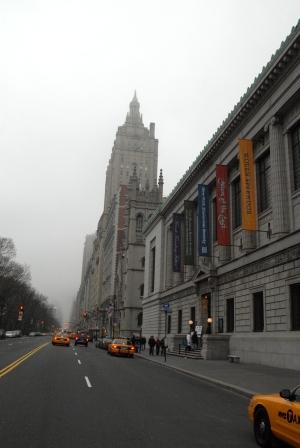 \
\
The Gala Reception on Friday evening included a classical music quartet, hors d’oeuvres and refreshments.

Many attendees wore ikat robes and other colorful eastern attire. Here is Jim Allen and his wife Linda in full, opulent regalia:

Marilyn Wolf gave some opening words and a pleasant evening was enjoyed by all, including a relaxing preview of the exhibition. It was announced that, after the exhibit closes on August 17th, arrangements have been made for it to travel to Washington to be shown at the Textile Museum.
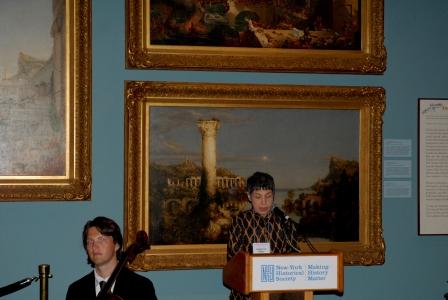
Photos of the exhibition were not allowed, although most of the pieces are reproduced in the book. It was interesting that many of the pieces had quite general labels, such as: “possibly Kazakhstan” or “Bag-face Turkmen Central Asia” or Turkmen Trapping Central Asia” (1). It is as though Turkmen studies had regressed by several decades. I will show a couple of these pieces in the Discussion segment of the Salon.
There were also some non-rug pieces with tentative attributions, too. A few pieces were decidedly 20th century, including a tiger-pelt Tibetan rug with “almost luminous synthetic dyes”, and a Qashqai chanteh where “the use of what is likely to be a synthetic dye for the orange means that it cannot be older than the early twentieth century” (2). There is also a Baluch chanteh “Though of no great age” (3).
The festivities were attended by hundreds of rug and textile enthusiasts from around the US, Great Britain, Turkey and Europe. Here are Cheri Hunter from LA, (author of the recent Hali 154 article Festivals, Fairs and Rituals in the Eastern Grasslands of Tibet), Donna Endres , (owner of Austin, Texas Istanbul to Samarkand Tribal Rug Gallery) and Bruce Baganz (2008 Joseph V. McMullan Award recipient and Textile Museum Board of Trustees President) in the lobby of the museum between seminars.
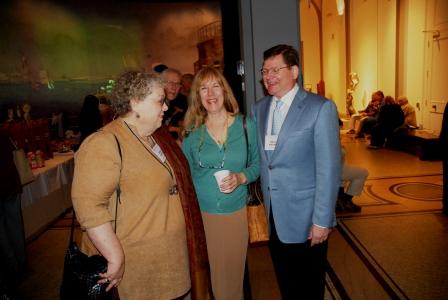
Here is Elisabeth Ettinghausen, art historian and wife of Islamic Arts expert Richard Ettinghausen, who died in 1979 and who wrote The Art and Architecture of Islam 650-1250.
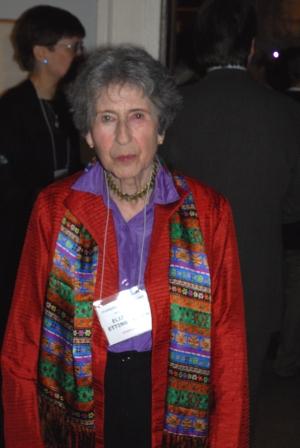
There were several rug dealers in attendance, too, but this gathering was quite a bit different from ICOC or ACOR events. There was no rug selling venue involved. At the big conferences, the rug dealers pretty much bankroll the show. They pay substantial amounts of money to the conference organizers in order to bring their wares to sell and are an integral part of those events.
The dealer money often funds venue rentals, speaker honorariums and refreshments (you can thank them effusively at the next conference). This fact likely contributed to the makeup of the attendees, since many rug folks who like to buy rugs to bring home from conferences did not attend. If you wanted to buy a rug in New York during this conference, you had to venture out on your own. Peter Davies had a few pieces for sale in the New York Historical Society store, including a voluptuous 19th century Qashqai horse blanket and several small bag faces.
The next day, Saturday, was the symposium.

I have attended a couple of ACORs and last year’s ICOC in Istanbul, but this was much different. This event was a distillation of the finest rug and textile speakers in the world today. At ICOC and ACOR conferences there are many more speakers on sometimes rather obscure topics, but these are the heavy hitters of the rug world. If you belong to a rug club, you may be fortunate to engage one of these speakers, but to have all of them together was a special treat. We were welcomed by DeWitt Mallary.

Dr. Jon Thompson needs no introduction. He authored the exhibition book Timbuktu to Tibet and was instrumental in selecting the articles for the exhibit. Here he is seen addressing the audience during his talk, and being scrutinized by his subject:

Daniel Walker, the Director of the Textile Museum, expounded on several topics, including analyzing fragments and paintings for clues to carpets which do not exist or which no longer remain intact.

Michael Franses, one of the founders of Hali and the ICOC, spoke about Anatolian Star Variant carpets. There was a single Star Ushak in the exhibit, donated by Henry du Pont to the Winterthur museum. Here he is seen with a very early group of rug collectors, or more likely Fishermen Presenting the Ring of St Mark to the Doge, with a star Ushak rug on the stairs.

Walter Denny spoke on the migration of carpet designs and the likely source of the coupled-column prayer rug design. He found no architecture in Anatolia or Persia with the coupled column design, but located buildings in Spain which existed around the time of the first rugs with this design. The design then traveled eastwards to Anatolia and beyond, perhaps with Jews who had been sent out of Spain and ended up in Istanbul, among other places.
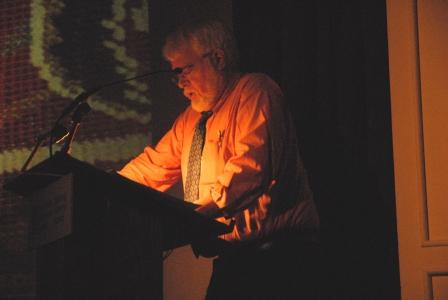
Louise Mackie, co-editor with Jon Thompson of the seminal tome, Turkmen, produced by the Textile Museum, spoke on the designs of imperial tents. She explored the iconography of a famous imperial tent supposed to have been captured during the siege of Venna. Her research revealed a near-identical Chinese jacket with the same design.

Thomas Farnham, an editor of Oriental Carpet and Textile Studies (affectionately known as OCTS) and Hajji Baba historian, gave a humorous and insightful presentation on the founders of the Hajji Baba.
The Sunday event was "An exclusive brunch in the heart of the Rug District of New York City", with a special one day exhibition, Old and Very Old Kilims of Anatolia from the Marshall and Marilyn Wolf collection. This is Marilyn Wolf enjoying the kilim display, resplendent in a cintamani-design blouse and Turkmen amulet pendant:

This picture shows Mehmet Çetinkaya, perhaps visiting some old kilim friends!

The display was hung in the Nazmiyal rug gallery in Manhattan. I took a walk around the “heart of the Rug District” before the brunch and encountered a half-dozen or more street-level rug stores selling mainly high-end decorator modern carpets. The Nazmiyal gallery is on the 2nd floor and is not evident from the street, so you would need to do some research before going on a rug-buying or viewing expedition to locate the shops with collectible pieces. Here are some kilim photos from the display:





I did happen onto a small shop in the SOHO neighborhood where a rolled-up Luri piece intrigued me, but when it was unrolled I saw that it was nearly threadbare, with holes everywhere. The gallery owner was planning to send it to India or Pakistan for “repair”. I was curious that a rug in that poor of condition could be rehabilitated, but apparently it is not only possible, but relatively inexpensive compared to having it done in Turkey or the US – lending credence to the old saying, “buyer beware”.
There are some rugs in museums around New York, but it was a big disappointment that the Metropolitan Museum is undergoing renovations and the entire Islamic department was closed. The Met is just across Central Park from the NY Historical Society. I suggest wearing warm clothing when you walk over there, so you don’t catch a cold: http://www.metmuseum.org/home.asp There are a few photos of some of the rugs in their collection on their web pages.
I took the subway back to the Historical Society museum to catch the last part of an exhibition walk-through with Dr. Thompson. Then it was back onto the crammed, humid subway system for more “systemic abuse” such as high decibel trains clattering by, street musicians playing, suspicious smells, close, cramped quarters and obnoxious fellow subway riders. It is much better, though, than taking your life in your hands on the surface streets – where it is safer to cross a street against the signal than when you have the right-of-way. You are fair game either way, both in the rug world and on the mean streets of New York.
FOOTNOTES:
1 - 3: Timbuktu to Tibet, Exotic Rugs and Textiles from New York Collections, Jon Thompson
First and last photos by MC Weiler, all others Patrick Weiler